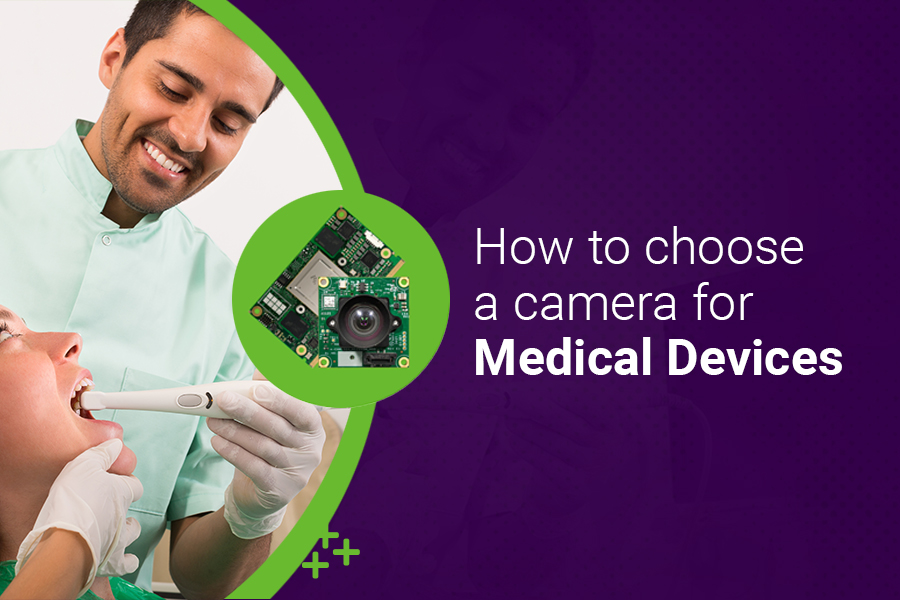Even though camera-enabled medical devices are often perceived as a recent innovation, they have been around for a while. These devices play a critical role in a person’s healthcare journey – whether diagnosis, treatment, or follow-ups. In recent times, however, the advancements in sensor technologies, artificial intelligence, and embedded processors have propelled the adoption of cameras in the medical industry – making camera-enabled devices the main catalysts of healthcare transformation.
In this blog, let’s look at the factors you need to consider while choosing a camera for medical devices. We will first learn what is a medical camera, how embedded vision is helping to enhance the performance of medical devices, and finally the 6 factors you need to keep in mind while choosing the camera.
What is a camera-enabled medical device?
Camera-enabled medical devices have been steadily becoming more mature in being able to effectively provide patient care. From diagnosis and detection to surgical guidance and fall detection, their role in the medical industry seems indefinitely expansive. In this growingly complex ecosystem of providers, patients, and hospitals, these embedded vision systems have a life-changing impact on the lives of millions of people while giving businesses the advantages of affordability, energy efficiency, and reliability.
Another example is the loupe camera used by modern operation theaters and dentists. Recorded from the surgeon’s (or doctor’s) point of view, it visually captures the procedure in the operating room – streaming it for training purposes. This is especially useful when the surgery involves small areas of the body, small incisions, blood flow, and surgical assistants.
Similarly, the number of use cases in medical devices where a camera helps to improve patient care and clinical processes is endless.
Application of AI in camera-enabled medical devices
The power of AI to do various analyses by leveraging algorithms is a giant leap over several MedTech barriers. Medical devices can now acquire, prepare, and analyze captured images to ensure accurate recognition in real-time. For instance, camera-enabled medical tracking devices help reduce hospital-stay (nosocomial) infections caused by insufficient hand hygiene. Keeping track of hand-hygiene compliance through a hospital is a challenge that can be solved by monitoring with the help of AI-powered vision. So, using AI algorithms, these tracking devices can detect any hygiene routines that may have been skipped and intervene in real-time.
There are many more use cases in medical care where artificial intelligence in combination with cameras is making life easier for patients, caregivers, and other medical care practitioners. We shall have a look at these use cases in detail in an upcoming article.
Factors to consider while choosing a camera for a medical device
Choosing a camera for a medical device is often complex. A single camera does not always meet all the imaging requirements of an application. Product developers many a time need to go for the ‘best possible camera’ than the ‘perfect camera’. However, doing this requires you to understand the key imaging requirements of your end application and mapping them to camera features. So let us look at some of the key camera-related features you need to look at to ensure you are able to meet the most critical imaging requirements of your medical device.
Resolution
The higher the resolution, the more the details that can be captured by the medical device. For instance a 4K medical camera can capture better details compared to a 2MP embedded camera. However, you don’t have to always go for a very high-resolution camera. Medical devices that require high level of detail such as medical microscopes, remote patient monitoring systems, skin scanners, telehealth devices, etc mostly will have to be equipped with a high resolution camera such as See3CAM_160 – 16MP autofocus USB camera from e-con Systems. On the other hand, some point of care devices, eye tracking systems, laboratory equipment, etc might not require a resolution beyond 5MP.
Chroma type
The chroma type in a camera has to be chosen based on the output requirement of your medical device. For instance, an embedded camera used to analyze skin tone needs to capture and process color information, in which case a color camera is required. However, a blood analyzer which has to read barcodes to do a check on the sample placement only needs to use a monochrome camera. An advantage of monochrome cameras is that they tend be more sensitive to light owing to the absence of CFAs (Color Filter Arrays).
Spectral performance
Most of the medical devices have to capture images only in the visible spectrum. However, certain applications such as vein finding, ICG fluorescence imaging for surgery, remote patient monitoring systems (during the night), etc. need to operate in the NIR (Near InfraRed) region. This is when an NIR camera is helpful. NIR cameras come with high QE (Quantum Efficiency) in the NIR spectrum – implying higher sensitivity in the region. This would mean that they are suitable for medical devices that have to capture images in the night, or operate under IR illumination.
Also, if you use an RGB-IR camera – that comes with both visible and IR pixels on the sensor – you could enable night vision capabilities without using an IR filter.
Sensitivity
Sensitivity in simple terms refers to the ability of a camera to respond to light. In an environment with restricted light, a low light camera module is required. If the scene contains both very bright and very dark areas, an HDR camera is recommended. Similarly, if there are strong reflections in the target scene, a camera with low blooming and smear is essential.
Shutter type
Cameras come in two shutter variants – a rolling shutter and a global shutter. The shutter type to be chosen depends on the nature of the object to be captured. If you need to capture fast moving objects and the output has rolling shutter artifacts in it, a global shutter camera module has to be used. However, in most of the cases, a high frame rate camera with low exposure time would be sufficient. It is a good idea to take the help of a camera expert to help you with making the choice between a rolling shutter and global shutter camera.
Optics
Choosing the right optics for your camera requires you to ask yourself the following questions:
- What is the distance of the target from the camera?
- What are the dimensions of the object you need to capture?
- Does the distance of the object vary or stay fixed?
- What is the field of view you wish to cover?
Once you have answers to the above question, you should be able to arrive at the focal length and other parameters of the lens you need to pick. For any help in choosing the right lens for your medical device, please write to us at camerasolutions@e-consystems.com.
Types of cameras offered by e-con Systems for medical devices
e-con Systems, with over 18 years of experience as an OEM Camera Solution Provider has catered to the embedded vision needs of the medical industry with great success. We offer multiple types of cameras, each with unique differentiators that separate them from others in the market. Some of them include:
- Cameras with a resolution ranging from 2MP to 18MP
- Rolling shutter and global shutter cameras
- Fixed focus and autofocus cameras
- Low light camera modules
- NIR cameras
- Color and monochrome cameras
Please visit the Camera Selector to have a look at the complete portfolio of our cameras by features.
We hope this blog gave you some useful information on the kind of cameras that are used in medical devices and what features you must make sure are a part of them.
If you are looking for help in integrating high-performance cameras into your MedTech devices or any other Life Sciences applications, please write to us at camerasolutions@e-consystems.com.

Balaji is a camera expert with 18+ years of experience in embedded product design, camera solutions, and product development. In e-con Systems, he has built numerous camera solutions in the field of ophthalmology, laboratory equipment, dentistry, assistive technology, dermatology, and more. He has played an integral part in helping many customers build their products by integrating the right vision technology into them.




